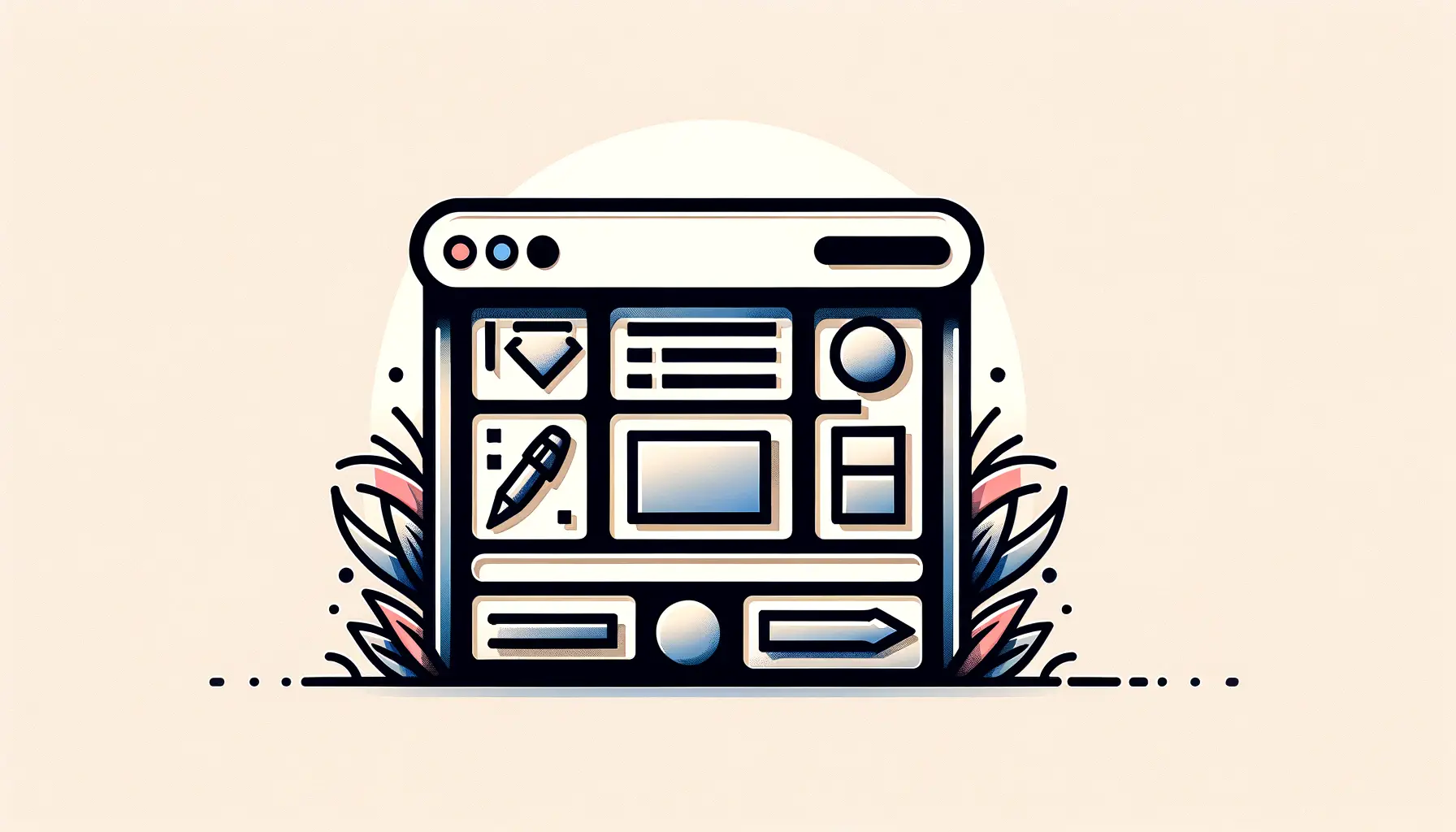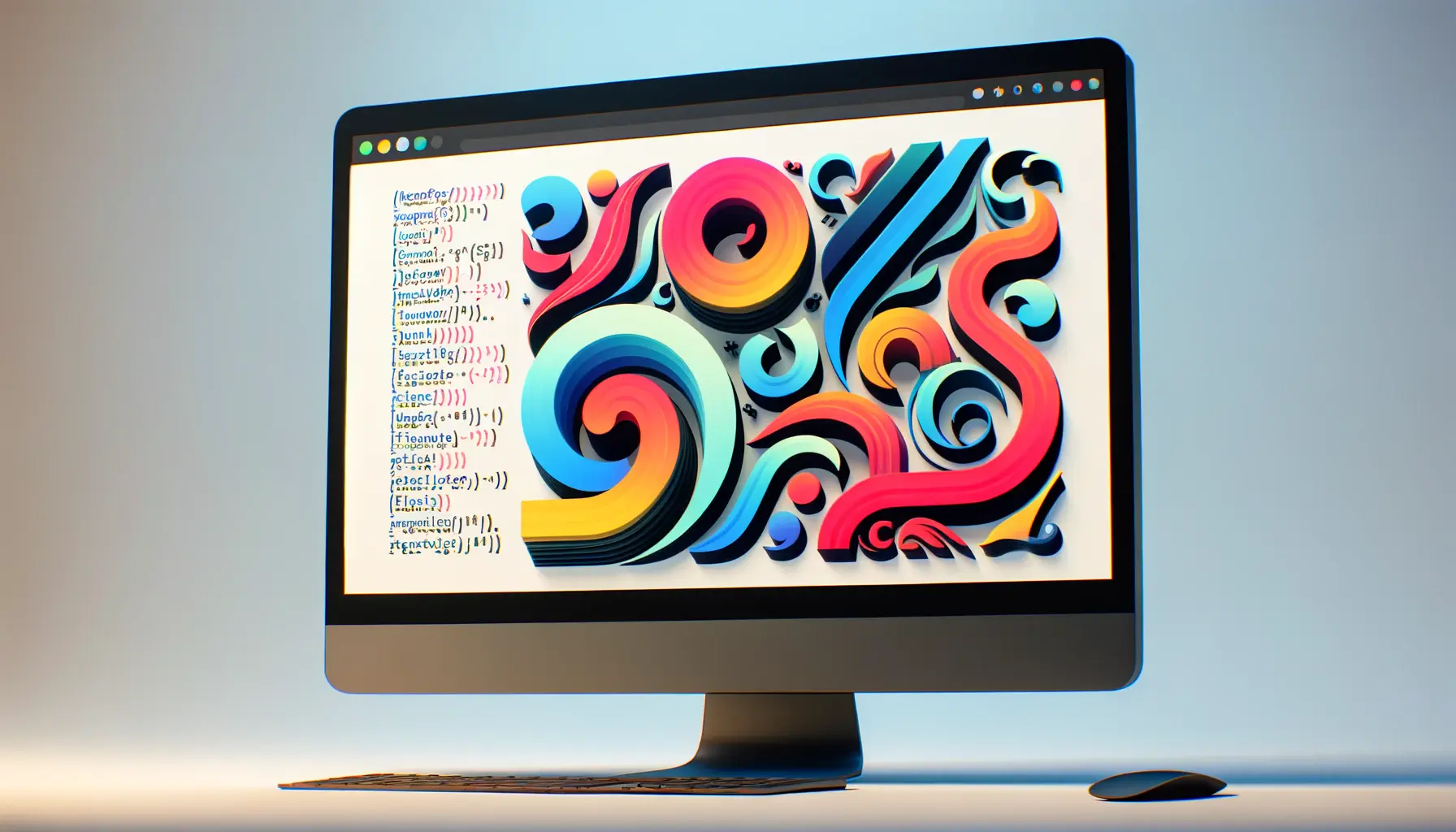Typography is an essential component of web design, contributing heavily to user interaction and experience.
Over the past ten years, custom typefaces have become increasingly common, giving designers the opportunity to introduce unique personality and branding into their web-based work.
Moving beyond generic fonts, custom typefaces provide a more personalized and engaging user experience, setting websites apart in an ocean of online presence.
- The Rise of Custom Typefaces in Modern Web Design
- Benefits of Having Custom Typefaces on Websites
- Challenges and Considerations in Implementing Custom Typefaces
- Best Practices in Creating and Using Custom Typefaces
- Case Studies: Successful Uses of Custom Typefaces
- The Impact of Custom Typefaces in Web Design
- Frequently Asked Questions About Custom Typefaces in Web Design
The Rise of Custom Typefaces in Modern Web Design
With the evolving web design landscape, custom typefaces have become a dominant trend, representing a shift toward more personalized and brand-specific online experiences.
This trend is fueled by the demand to create distinctive visual identities that resonate with target audiences.
Traditionally, web designers were limited to a small set of web-safe fonts to guarantee uniform display across devices.
However, with the progress of web technologies, these options have expanded, allowing custom typefaces to be easily incorporated into websites.
This has given designers the freedom to break away from generic typographyThe art and technique of arranging type to make written language legible, readable, and visually appealing., adopting distinctive typefaces that align with a brand’s message and identity.
Understanding Custom Typefaces
Custom typefaces are unique fonts created specifically to capture the personality and values of a brand.
Unlike standard fonts, which are widely available and commonly used, custom typefaces offer uniqueness and originality.
They serve as a visual embodiment of a brand’s identity, ensuring a consistent and recognizable user experience across all digital media.
Historical Context: From Common Fonts to Custom Designs
The shift from generic fonts to custom typefaces marks a significant milestone in web typography.
During the early days of the internet, designers relied on a limited set of web-safe fonts to ensure legibility and compatibility across different devices and browsers.
This restriction often led to dull and uniform typography.
As web technologies advanced, so did font embeddingThe process of including font files within a web page to ensure consistent typography across different devices. capabilities.
The introduction of @font-faceA CSS rule that allows web designers to specify custom fonts to be downloaded and displayed in a browser. in CSS allowed designers to embed custom typefaces directly into web pages, fostering a more diverse and creative typographic expression.
This progression has led to today’s widespread use of custom typefaces, where brands invest in unique font designs to differentiate themselves and enhance their visual storytelling.
Factors Driving the Popularity of Custom Typefaces
Several key factors contribute to the rising popularity of custom typefaces in modern web design:
- Brand Differentiation: In an oversaturated online market, unique typography allows businesses to stand out and establish a distinctive visual identity.
- Enhanced User Engagement: Custom typefaces can be designed to evoke specific emotions and associations, creating a richer and more immersive user experience.
- Technological Advancements: Improvements in font loading and rendering technology have made it easier to implement custom typefaces without compromising performance.
- Creative Freedom: Designers now have greater flexibility to experiment with typography, resulting in more innovative and customized web experiences.
By embracing custom typefaces, companies can effectively express their personality and values, fostering deeper engagement with their audience on a more intimate level.
Custom typefaces are reshaping web design by allowing brands to create unique visual identities, enhancing user engagement, and offering more personalized online experiences.
Benefits of Having Custom Typefaces on Websites
In today’s competitive world of internet living, custom typefaces can be a phenomenal means to elevate brand personality, improve the user experience, and create a unique online image.
While common fonts provide consistency, they often lack the personality and uniqueness required to leave a lasting brand impression.
Let’s explore some of the finest benefits of using custom typefaces in website design.
Enhancing Brand Recognition and Identity
Branding is not just about a logo—it encompasses all the visual elements of a website, including typography.
Custom typefaces allow brands to create a unique and recognizable identity that sets them apart from others.
When users consistently see a specific font associated with a brand, they are more likely to recognize and trust it.
- Consistency Across Platforms: A custom typeface guarantees that a brand’s visual identity remains uniform across websites, mobile apps, and other digital platforms.
- Stronger Emotional Connection: Different fonts evoke different emotions. A well-designed custom typeface can reinforce brand values, whether they reflect professionalism, creativity, or luxury.
- Memorability: Customers are more likely to remember a brand with a unique font, making it stand out in a crowded market.
Enhancing User Experience and Readability
Readability is a critical aspect of web design.
A poorly chosen font can make content difficult to read, leading to high bounce rates and frustrated users.
Custom typefaces are designed with usability in mind, ensuring a seamless reading experience.
- Optimization for Digital Screens: Custom typefaces are usually optimized for web use to provide better readability across different screen sizes and resolutions.
- Balanced Aesthetics and Functionality: Unlike standard fonts, which may not align well with a brand’s tone, custom typefaces can be tailored to maintain both beauty and readability.
- Accessibility Considerations: A well-crafted custom typeface can enhance accessibility for visually impaired users by improving contrast and clarity.
Securing Differentiation in a Competitive Online Environment
With so many websites competing for attention, differentiation is crucial.
Custom typefaces enable websites to move beyond standard typography trends and establish a distinct online identity.
- Having a Distinct Visual Identity: Using a custom typeface ensures that no other brand shares the same appearance and feel.
- Creating a Comprehensive Brand Experience: Custom typography integrates seamlessly with a brand’s overall design strategy, making the user experience more intentional and polished.
- Creating Brand Affinity: When users associate a unique font with a brand, they develop a stronger sense of familiarity and reliability.
By leveraging custom typefaces, brands can create a more engaging and immersive web experience that leaves a lasting impression on their visitors.
Using custom typefaces helps businesses establish a unique identity, improve readability, and strengthen brand recall among users.
Challenges and Considerations in Implementing Custom Typefaces
Although custom typefaces can significantly enhance a website’s visual impact and brand identity, their implementation comes with several challenges and considerations.
Addressing these aspects is crucial to maximizing the advantages of custom typefaces without compromising user experience and site performance.
Technical Challenges: Compatibility and Performance
The introduction of custom typefaces presents technical challenges that can impact both compatibility and performance:
- Browser Compatibility: Different browsers and operating systems may render fonts differently, leading to variations in appearance. Ensuring that custom typefaces appear as intended across various platforms requires extensive testing and, in some cases, the use of fallback fonts.
- Loading Times: Custom typefaces often need to be downloaded when a user visits a site, which can slow down page loading times. If not managed properly, this can result in a poor user experience. Techniques such as font subsetting and using efficient font formats can help mitigate these issues.
Balancing Creativity with Accessibility
While custom typefaces allow for creative expression, it is essential to balance aesthetics with accessibility:
- Readability: Highly stylized fonts can be visually appealing but may compromise readability, particularly for users with visual impairments. It is vital to ensure that custom typefaces maintain optimal legibility.
- System Fonts Consideration: System fonts are already installed on users’ devices, eliminating the need for additional downloads and ensuring consistent rendering. Relying solely on custom typefaces can overlook the performance and compatibility benefits offered by system fonts.
Cost Implications of Developing Custom Fonts
The creation and implementation of custom typefaces require financial investment:
- Development Expenses: Designing a custom typeface requires specialized expertise and can be costly, particularly for small businesses.
- Licensing Fees: Using certain custom typefaces may involve licensing fees, which can impact overall budgets. It is crucial to understand the terms of the font license and ensure compliance to avoid legal issues.
By carefully addressing these challenges and incorporating best practices, designers can effectively utilize custom typefaces to enhance a website’s aesthetic appeal without compromising functionality and accessibility.
While custom typefaces offer branding advantages, poor implementation can lead to performance and compatibility issues.
Best Practices in Creating and Using Custom Typefaces
Custom typefaces can significantly contribute to your brand’s personality and user experience when used effectively in web design.
To maximize their benefits, it is essential to follow best practices that ensure both aesthetic appeal and usability.
Choosing the Correct Typeface
Selecting the right custom typeface that aligns with your brand’s identity and message is crucial.
Consider the following factors:
- Brand Alignment: Ensure the typeface reflects your brand’s tone and values, whether professional, playful, or innovative.
- Legibility: Prioritize readability across various devices and screen sizes to provide a seamless user experience.
- Versatility: Choose a custom typeface that works well in different contexts, including headings, body text, and call-to-action buttons.
Technical Integration of Custom Fonts
Proper technical integration is critical to ensure that custom typefaces enhance your website without compromising performance:
- Use Modern Font Formats: Implement font formats like WOFF2 for better compression and faster loading.
- Optimize Font Loading: Utilize strategies such as font preloading to ensure text remains visible while fonts are loading, improving the user experience.
- Ensure Accessibility: Verify that your custom typefaces meet accessibility standards and maintain legibility for all users.
Developing a Harmonious Typography System
Creating a cohesive typography system ensures consistency and enhances overall web design:
- Establish Visual Hierarchy: Structure content by utilizing contrasts in font size, weight, and style to guide users through your website effectively.
- Maintain Consistency: Limit the number of typefaces used to two or three to avoid a cluttered appearance and maintain a professional look.
- Pair Fonts Thoughtfully: When combining different custom typefaces, ensure they complement each other to create a visually harmonious experience.
By implementing these best practices, you can successfully incorporate custom typefaces into your web design, creating a visually appealing, user-friendly, and accessible website that resonates with your audience.
To maximize the effectiveness of custom typefaces, ensure they align with brand identity, remain legible, and are optimized for web performance.
Case Studies: Successful Uses of Custom Typefaces
Several companies have successfully utilized custom typefaces to enhance their visual presence and user experience.
These case studies illustrate the real-world benefits of integrating unique typography into website design.
Boehringer Ingelheim’s Global Rebrand
Boehringer Ingelheim, a global pharmaceutical company, collaborated with Monotype to create custom typefaces as part of their rebranding initiative.
The project aimed to establish an integrated and dynamic typographic system capable of supporting various platforms and languages while enhancing brand consistency and recognition.
Rocket Mortgage’s Modern Branding
Rocket Mortgage partnered with Monotype to develop a bespoke custom typeface that revitalized their visual brand identity and ensured cohesion across all customer touchpoints.
This custom typography played a significant role in creating a unified brand experience, fostering trust, and strengthening credibility with users.
Picsart’s Dynamic Collaboration
Picsart, a leading online creation platform, teamed up with Monotype to provide a diverse range of custom typefaces to its global audience.
This collaboration enabled creators to design unique content, improving user engagement and satisfaction.
National Portrait Gallery’s Renewed Identity
As part of its rebranding strategy, the National Portrait Gallery in London collaborated with Monotype to design a custom typeface.
The new typography paid homage to the gallery’s rich legacy while incorporating a modern aesthetic, broadening its appeal and enhancing the visitor experience.
M&M’S Inclusive Rebranding
M&M’S underwent a contemporary redesign, introducing a new font called ‘All Together.’ This custom typeface is bold, warm, playful, and conversational, aligning with the company’s renewed focus on inclusivity and fostering a sense of belonging.
These examples demonstrate how well-crafted custom typefaces can play a pivotal role in solidifying brand identity, enhancing user engagement, and differentiating a company in a competitive digital landscape.
Successful brands, such as Boehringer Ingelheim and Rocket Mortgage, have leveraged custom typefaces to strengthen their brand identity.
The Impact of Custom Typefaces in Web Design
Typography plays a fundamental role in defining the web experience, and with the introduction of custom typefaces, the way people communicate online has changed forever.
From creating unique identities to improving user interaction, custom typefaces have evolved beyond aesthetics—they are essential assets that communicate a brand’s digital identity.
Key Implications of Custom Typeface Implementation
Throughout this article, we have explored how custom typefaces can redefine web design.
Below are the most important takeaways:
- Brand Identity Enhancement: Businesses can create a distinctive brand presence through custom typefaces, ensuring visual consistency across different media platforms.
- Improved User Experience: Thoughtfully designed and readable typography enhances navigation and content consumption, leading to better engagement.
- Differentiation in a Competitive Environment: Unique typography sets brands apart from competitors, reinforcing their message and values.
- Considerations to Overcome: While custom typefaces offer numerous advantages, careful implementation is necessary to avoid challenges like slow loading times, accessibility issues, and compatibility concerns.
- Implementation Best Practices: Selecting the right font style, optimizing font performance, and ensuring accessibility are essential steps for successfully integrating custom typefaces into web design.
The Future of Custom Typefaces in Web Design
Web typography continues to evolve with emerging technologies and design trends.
As brands seek more ways to establish a strong digital presence, custom typefaces will remain an integral part of branding.
Innovations such as variable fontsA type of font technology that allows multiple styles (weight, width, slant) to be contained in a single file., AI-driven typographyThe use of artificial intelligence to generate and optimize fonts based on user preferences and data insights. design, and responsive typography solutions will continue to shape how fonts adapt to different screen sizes and user interactions.
Final Thoughts
The use of custom typefaces in web design is more than just a visual enhancement—it is a strategic tool that bridges creativity and functionality.
Typography not only strengthens a brand’s identity but also plays a crucial role in improving the user experience.
Businesses that invest in custom typefaces gain a competitive edge by establishing a distinctive presence and leaving a lasting impression on their audience.
As the digital space continues to evolve, custom typefaces will become an essential component for brands aiming to stay ahead.
By understanding the benefits, challenges, and best practices, designers and businesses can make informed decisions that enhance their online presence through innovative and well-executed typography.
Custom typefaces contribute to brand differentiation, enhance user experience, and play a key role in digital branding strategies.
Quality web design is key for a great website! Check out our service page to partner with an expert web design agency.
Frequently Asked Questions About Custom Typefaces in Web Design
A custom typeface is a unique font specifically created for a project or brand, reinforcing brand identity and ensuring visual consistency across digital platforms.
Custom typefaces help distinguish your brand, enhance user experience, and communicate brand personality more effectively than standard fonts, making your website more memorable.
Most modern browsers support custom typefaces, but testing across different browsers and devices is necessary to ensure consistent appearance and performance.
Yes, custom typefaces can impact website loading times.
Compressing font files and using efficient loading techniques can help optimize performance without compromising quality.
While custom typefaces do not directly influence SEO, maintaining optimal site performance and readability is essential to ensure a positive user experience, which can indirectly affect search rankings.
Ensure you have the proper licensing for any custom typefaces used.
Unauthorized use can lead to legal consequences, including fines and potential restrictions on font usage.
Yes, custom typefaces can be designed to be fully responsive, ensuring readability and visual appeal across various screen sizes and resolutions.
Consider your brand personality, target audience, and the emotions you want to evoke.
Consulting with a professional typographer can help in selecting an ideal custom typeface.
Yes, designing and licensing custom typefaces involves costs.
Prices vary based on complexity, designer expertise, and usage rights.












